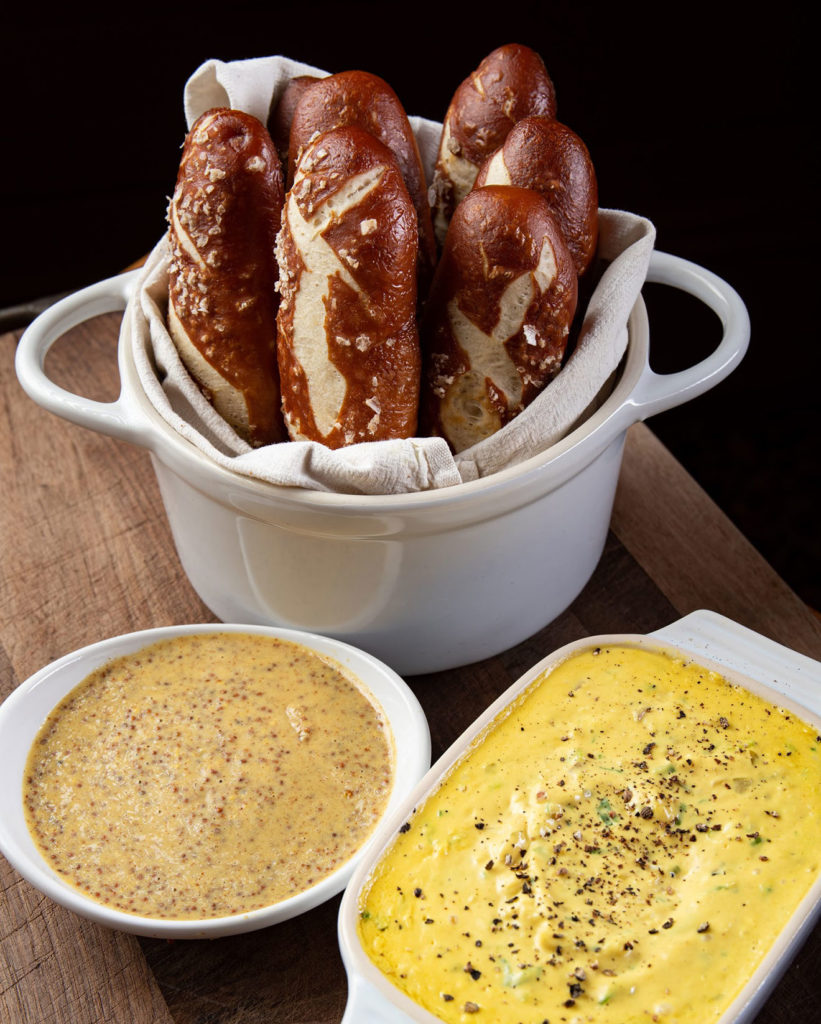Pretzel

Typical Ingredients
- Wheat
- Yeast
- Salt
- Water
- Sugar
- Lye
Pairs With...
- Munich Dunkel
- Munich Helles
HISTORY
It was around 610 BCE when legend has it that, in a secluded monastery in either Northern Italy or Southern France, lived a monk with a twisted sense of humor. As a reward to his students for learning their prayers, this monk handed out baked pieces of leftover bread twisted together to resemble crossed arms, which was a traditional prayer pose. He called them “pretiola,” which is Latin for “little rewards.” What’s more, the three-holed “pretiola,” claimed the monk, represented the Holy Trinity of the Father, Son and Holy Spirit. The etymology of the word may not prove this story to be entirely true, but certainly shows that the pretzel crumbs lead back to the Catholic Church. Some scholars believe that the word “pretzel” is not a corruption of the Latin word “pretiola,” but rather comes from the Old German “brezitella” from the Latin for “arm” (bracchiatus). There’s also evidence that they could have started as a food meant to be eaten during lent to replace meat.
During the Middle Ages, monks gave away pretzels to the poor as a religious symbol that additionally provided literal sustenance. Because of this, the twisted snack caught on as a sign of fulfillment, good fortune and prosperity. It started popping up in medieval art as a lucky symbol, most famously in Herrad of Landsberg’s encyclopedia Hortus Deliciarum. A 12th-century German nun, Herrad depicted pretzels as an important part of any feast.
In the 16th century, it was heroic pretzel bakers who saved Vienna from ransacking by Ottomon Turks. The story goes that in 1529, soldiers from the Ottoman Empire began the Siege of Vienna by tunneling underneath the Austrian city under the cover of darkness. However, several monks in the monastery’s basement, hard at work making the next day’s pretzels, overheard the commotion. They quickly alerted the city leadership and military. By doing this, the monks were able to thwart the attack and save lives. In thanks, the Austrian emperor gave the pretzel bakers their own coat of arms which included angry lions holding a pretzel. It’s still used at European pretzel shops today.
CLASSIC CHARACTERISTICS:
Aroma – Fresh baked bread. Malt. Yeast.
Appearance – The typical pretzel has a pleasant cracker-like flavor, a crisp, brittle texture and a brown glossy surface color. Salt crystals are often sprinkled on its surface.
Flavor – Malt. Yeast. Salty.
Mouthfeel – Warm & soft on the inside, chewy throughout, with an exterior crust.
Pairs With – Munich / Bavarian Beers (Helles & Dunkel are superb)
Service Notes:
Serve fresh and hot with Beer mustards & beer (Pub) cheese
Commercial Examples
- Patrick’s Artisan Bakery, Soft Pretzels
- Auntie Annes, Soft Pretzels
- Snyder’s of Hanover, Variety Pretzels
- Rold Gold, (Frito Lay) Variety Pretzels
- Pretzel Crisps, Thin Pretzel Chips
- SUPERPRETZEL, Frozen Soft Pretzels
Varieties:
Small Hard Twist, Soft/Hard Nuggets (bites), Large Soft Pretzel, Sticks, Pretzel Crisps, Peanut Butter filled Nuggets
Cooking PROCESS:
- Bloom yeast with sugar and warm water.
- Mix melted butter, flour, salt & bloomed yeast.
- Once homogenous, mix on medium speed for 10 minutes.
- Rest Dough for 30 minutes. Portion and freeze.
- Place each frozen pretzel in a lye bath for 30 seconds then remove and garnish. Bake for 15 minutes, rotate and bake again for another 15 until golden brown. Serve.
Tasting Notes:
The typical pretzel has a pleasant cracker-like flavor, a crisp, brittle texture and a brown glossy surface color. Salt crystals are often sprinkled on its surface to make them taste more appealing. Pretzels have a moisture content of anywhere from 2-4% and therefore have a very long shelf life.